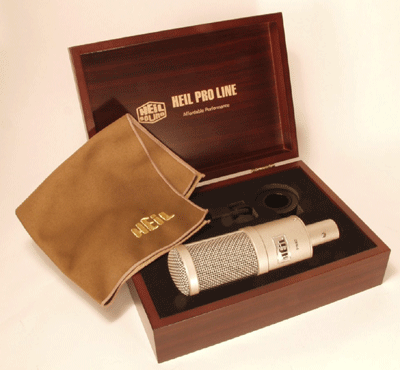
Barry's Mix Magazine Equipment And Software Reviews
Barry's Massive Discography And Engineering Career
Barry's Music Connection Magazine Reviews
Barry's Resolution Magazine Reviews
Heil Sound PR 40 Dynamic Microphone
By Barry Rudolph

Although Heil Sound has decades of experience in the live sound and custom home theater industries, and is highly regarded for its quality microphones for amateur radio and communications, you may not have equated the company with studio mics--until now. Its new PR 40 is a large-diaphragm, front-address mic that makes the transition from stage to broadcast studio to recording studio with ease. INSIDE A HEIL
The PR 40's components are made in the UK, Malaysia, Japan, China and Taiwan, and then shipped to the U.S. for final assembly and test. The PR 40 uses the DM 6 dynamic element with a 1.25-inch diaphragm for a response down to 28 Hz (-3dB point) and flat up through 18 kHz (-3 dB). There is a broad, 3dB peak in the 4- to 5kHz region, which accounts for this microphone's forward but not nasal sound. The humbucking copper voice coil has a center tap (connected to ground) and uses a neodymium magnet structure for a magnetic field 10 times stronger than the traditional magnets in other microphones. Humbucking allows this mic to work perfectly around computer monitors and high-RF (radio frequency) energy fields that are common at commercial broadcast facilities. An end-fire, low-mass, quilted aluminum diaphragm gives the PR 40 excellent low-frequency response and low distortion throughout its wide frequency range. WORKING WITH VOCALS
I found the Heil to excel primarily at vocal and narration recording. There is plenty of output level, and the top end is noticeably open and airy--much like a condenser model. I compared the PR 40 to an Electro-Voice RE-27N/D, a newer variant of the famed RE-20 Variable-D dynamic, and found my vocalist was thinner-sounding on the E-V. Singing only two inches away from each mic meant that the proximity effect was the main reason why the PR 40 was fatter. (The E-V's design allows no proximity effect.) Doubling the distance from both mics evened the score, although the PR 40 still produced a touch more low-end size. "P" popping was almost non-existent on the PR 40--it is well-damped and hard to cause an offending plosive. For recording guitar, I compared the Heil to two guitar mic stalwarts: a Shure SM57 and Sennheiser MD-421U. The PR 40 sounded very good, with a clear and open HF shine. Aiming slightly off-center of the speaker gave me a good balance of brightness and warmth. The SM57 provided an "in-your-face", edgy and compressed guitar sound with a lot less bass. The MD-421U sounded very smooth with good bottom end, but it was duller than the PR 40. Next up were kick, snare and tom-toms. At another studio, I used a PreSonus M80 mic preamp and around 20 dB of gain to obtain a good level into Pro Tools|HD at 24-bit/96 kHz. I compared the Heil to a new SM57, a Beyer M88 and a MD-421U. With the PR 40 on kick (an 18-inch Slingerland using a wood beater), I got more subsonic frequencies and a brighter attack than with the other mics. The M88 was rounder in the low midrange but had less snap in the attack. Both mics sounded good, but the Heil pulled a surprising amount of subsonic low end out of the small kick drum. Repositioning the PR 40 so that it was aimed away from the beater, it produced less attack and more roundness. The vintage 1967 Ludwig 6.5-inch snare sounded thinner on the Heil than an SM57. Both mics were about 10 inches away from the center of the head. The 57 had more guts in the low midrange, while the Heil was brighter. The Heil's physical size and inability to fit in close to get proximity effect on a full kit would preclude it from being used as a snare mic. A 10-inch Slingerland tom-tom sounded good through the PR 40, MD-421U and 57. The 57, predictably, was more nasal, with a rolled-off top and bottom, while the 421 ended up being very close to the Heil with a good top and bottom. Again, the Heil had more attack — very much like a condenser but with much better rejection of leakage from the rest of the kit. VERSATILE, RUGGED, AFFORDABLE
Heil Sound, 618/257-3000, www.heilsound.com
|
|
|
|
All Web Page Design Is Copyright © 2005 through By Barry Rudolph